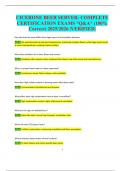CICERONE BEER SERVER- COMPLETE
CERTIFICATION EXAMS *Q&A* (100%
Correct) 2025/2026 |VERIFIED|
Describe how ale yeast differs from lager yeast in fermentation behavior.
Ale yeast ferments at warmer temperatures, producing complex flavors, while lager yeast works
at cooler temperatures, creating cleaner profiles.
What does oxidation do to beer flavor and aroma?
Oxidation often imparts stale, cardboard-like flavors and dulls aroma and hop bitterness.
Why is a proper foam head on a beer important?
It enhances aroma, flavor release, and mouthfeel.
How does high sulfate content in brewing water affect beer taste?
It accentuates hop bitterness and dryness.
What effect does high carbonation have on beer’s mouthfeel?
High carbonation creates a light, effervescent mouthfeel.
What are the signs of oxidized beer?
Paper-like taste, loss of hop character, and darker color.
What role does CO2 play in beer?
It affects carbonation, enhancing mouthfeel and flavor perception.
Why do brewers adjust water mineral content?
To tailor flavors and match specific beer styles.
1
,What temperature range is typical for lager yeast fermentation?
Around 45-55°F (7-13°C).
How does beer’s temperature affect its perceived flavor?
Warmer beer tends to release more aroma and flavor compounds, enhancing its profile, while
colder beer often subdues certain notes.
Why is it essential to store beer away from light?
Light exposure causes skunky off-flavors, especially in beers packaged in clear or green bottles.
What is diacetyl, and what does it taste like in beer?
It is a byproduct of fermentation that can give beer a buttery or butterscotch-like flavor.
What is the purpose of malt in brewing beer?
Malt provides the sugars needed for fermentation, contributes to beer’s color, body, and flavors
such as sweetness and caramel notes.
What does IBU measure in beer?
International Bitterness Units (IBUs) measure the perceived bitterness from hops in beer.
What characteristic does a highly attenuated beer exhibit?
It will have a drier finish due to more complete fermentation of sugars.
Why is it recommended to rinse beer glasses with cold water before pouring?
It helps remove any residues and reduces excess foam by cooling the glass surface.
What is the primary flavor contribution of hops in beer?
Hops contribute bitterness, aroma, and flavors such as citrus, pine, or floral notes.
2
,How does a nitro pour differ from a standard CO2 beer pour?
Nitro pours produce a creamy mouthfeel and a dense, cascading head due to nitrogen gas use.
What causes beer haze?
Protein and polyphenol particles can cause haze, but some beer styles retain it intentionally for
flavor.
What are adjuncts in brewing?
Additional fermentable ingredients like corn, rice, or sugar used to influence flavor, color, or cost.
What temperature is best for storing most beers long-term?
Around 50-55°F (10-13°C) in a cool, dark place.
Why are bottle-conditioned beers carbonated differently?
They undergo secondary fermentation in the bottle, naturally producing CO2.
How can draft system line cleaning affect beer quality?
Dirty lines introduce off-flavors and contaminants, degrading beer quality.
What are the key characteristics of a Saison?
Spicy, fruity, and often dry, with a refreshing taste and moderate carbonation.
Why do some beers have a sour taste?
Lactic acid bacteria or wild yeasts like Brettanomyces contribute to intentional sourness in
specific styles.
What does SRM measure in beer?
Standard Reference Method (SRM) measures beer color intensity.
3
, What off-flavor can excessive yeast autolysis produce?
A rubbery or meaty taste due to yeast cell breakdown.
What should you check before serving a draft beer?
Ensure the glass is clean, the system pressure is balanced, and beer lines are clean.
What type of aroma can old hops contribute?
Old or improperly stored hops can create cheesy or stale aromas.
Why is barley malt preferred in brewing?
Its enzymes and husk structure make it ideal for mashing and providing fermentable sugars.
What is a beer’s “head retention”?
The foam’s ability to stay intact on top of the beer after pouring.
What impact do roasted malts have on beer?
They contribute dark colors and flavors like coffee, chocolate, or toasty notes.
How does beer aging typically affect hop aroma?
It decreases, leading to a more subdued hop presence over time.
What are phenolic flavors, and where do they come from?
Spicy, smoky, or medicinal flavors often come from yeast or wild fermentation.
Why do different beer styles require distinct serving glasses?
The glass shape enhances aroma, presentation, and flavor perception.
4




